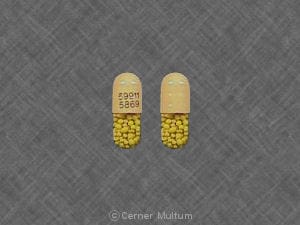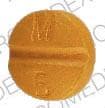Dosage Forms
Excipient information presented when available (limited, particularly for generics); consult specific product labeling. [DSC] = Discontinued product
Capsule, Oral:
Minocin: 50 mg, 75 mg [DSC], 100 mg [DSC] [contains brilliant blue fcf (fd&c blue #1), fd&c yellow #10 (quinoline yellow)]
Generic: 50 mg, 75 mg, 100 mg
Capsule Extended Release 24 Hour, Oral:
Ximino: 90 mg [contains brilliant blue fcf (fd&c blue #1)]
Ximino: 45 mg [contains brilliant blue fcf (fd&c blue #1), fd&c yellow #10 (quinoline yellow), fd&c yellow #6 (sunset yellow)]
Ximino: 135 mg [contains brilliant blue fcf (fd&c blue #1), fd&c yellow #6 (sunset yellow)]
Kit, Combination:
Minocin: 50 mg [DSC], 100 mg [DSC] [contains brilliant blue fcf (fd&c blue #1), disodium edta, fd&c yellow #10 (quinoline yellow), sodium benzoate]
Solution Reconstituted, Intravenous [preservative free]:
Minocin: 100 mg (1 ea)
Tablet, Oral:
Generic: 50 mg, 75 mg, 100 mg
Tablet Extended Release 24 Hour, Oral:
CoreMino: 45 mg, 90 mg, 135 mg
Minolira: 105 mg, 135 mg [scored]
Solodyn: 55 mg [contains fd&c red #40]
Solodyn: 65 mg [contains brilliant blue fcf (fd&c blue #1), fd&c blue #2 (indigotine), fd&c yellow #10 (quinoline yellow)]
Solodyn: 80 mg [contains fd&c blue #2 (indigotine), fd&c red #40, fd&c yellow #6 (sunset yellow)]
Solodyn: 105 mg [contains brilliant blue fcf (fd&c blue #1)]
Solodyn: 115 mg [contains brilliant blue fcf (fd&c blue #1), fd&c blue #2 (indigotine), fd&c yellow #10 (quinoline yellow)]
Generic: 45 mg, 55 mg, 65 mg, 80 mg, 90 mg, 105 mg, 115 mg, 135 mg
Pharmacology
Mechanism of Action
Inhibits bacterial protein synthesis by binding with the 30S and possibly the 50S ribosomal subunit(s) of susceptible bacteria; cell wall synthesis is not affected.
Pharmacokinetics/Pharmacodynamics
Absorption
Oral: Well absorbed
Distribution
Widely distributed to most body fluids, bile, and tissues; poor CNS penetration; deposits in fat for extended periods; Vd: 0.14 to 0.7 L/kg (Zhanel 2004)
Metabolism
Hepatic to inactive metabolites
Excretion
Urine (5% to 12% excreted unchanged) (Brogden 1975; Zhanel 2004); feces (20% to 34%) (Brogden 1975)
Time to Peak
Capsule, pellet filled: 1 to 4 hours; Tablet: 1 to 3 hours; Extended release tablet: 3.5 to 4 hours
Half-Life Elimination
IV: 15 to 23 hours; 11 to 16 hours (hepatic impairment); 18 to 69 hours (renal impairment); Oral: 16 hours (range: 11 to 17 hours)
Protein Binding
55% to 96% (Zhanel 2004)
Use: Labeled Indications
Acute intestinal amebiasis: Adjunctive therapy to amebicides in the treatment of acute intestinal amebiasis
Acne:
Oral (immediate release) and IV: Adjunctive therapy for the treatment of severe acne
Oral (extended-release): Treatment of only inflammatory lesions of non-nodular moderate to severe acne vulgaris in patients 12 years and older
Actinomycosis: Treatment of actinomycosis caused by Actinomyces israelii when penicillin is contraindicated
Anthrax: Treatment of anthrax caused by Bacillus anthracis when penicillin is contraindicated
Asymptomatic carriers of Neisseria meningitidis: Oral (immediate-release): To eliminate the meningococci from the nasopharynx of asymptomatic carriers of N. meningitidis
Campylobacter: Treatment of infections caused by Campylobacter fetus
Cholera: Treatment of cholera caused by Vibrio cholerae
Clostridium: Treatment of infections caused by Clostridium spp when penicillin is contraindicated
Gram-negative infections: Treatment of infections caused by Acinetobacter spp, Escherichia coli, Enterobacter aerogenes, Shigella spp
Listeriosis: Treatment of listeriosis due to Listeria monocytogenes when penicillin is contraindicated
Meningitis: Treatment of meningitis due to Neisseria meningitidis when penicillin is contraindicated
Ophthalmic infections: Treatment of inclusion conjunctivitis or trachoma caused by Chlamydia trachomatis
Relapsing fever: Treatment of relapsing fever caused by Borrelia recurrentis
Respiratory tract infections: Treatment of respiratory tract infections caused by Haemophilus influenzae, Klebsiella spp, or Mycoplasma pneumonia. For the treatment of upper respiratory tract infections caused by Streptococcus pneumoniae.
Rickettsial infections: Treatment of Rocky Mountain spotted fever, typhus fever and the typhus group, Q fever, rickettsialpox, and tick fevers caused by Rickettsiae
Sexually transmitted infections: Treatment of lymphogranuloma venereum caused by C. trachomatis; nongonococcal urethritis, endocervical, or rectal infections in adults caused by Ureaplasma urealyticum or C. trachomatis; donovanosis (granuloma inguinale) caused by Klebsiella granulomatis; syphilis caused by Treponema pallidum subspecies pallidum, when penicillin is contraindicated
Skin and skin structure infections: Treatment of skin and skin structure infections caused by Staphylococcus aureus (not considered a first-line agent for any staphylococcal infection)
Urinary tract infections: Treatment of urinary tract infections caused by Klebsiella species
Vincent infection: Treatment of Vincent infection caused by Fusobacterium fusiforme when penicillin is contraindicated
Yaws: Treatment of yaws caused by T. pallidum subspecies pertenue when penicillin is contraindicated
Zoonotic infections: Treatment of psittacosis (ornithosis) due to Chlamydia psittaci; plague due to Yersinia pestis; tularemia due to Francisella tularensis; brucellosis due to Brucella spp (in conjunction with streptomycin); bartonellosis due to Bartonella bacilliformis
Use: Off Label
Cellulitis (purulent) due to community-acquired MRSAyes
Based on the Infectious Diseases Society of America (IDSA) Clinical Practice Guidelines for the Treatment of Methicillin-Resistant Staphylococcus Aureus Infections in Adults and Children, minocycline is effective and recommended in the outpatient management of purulent cellulitis due to community-acquired methicillin-resistant S. aureus (MRSA).
Leprosyyes
Based on the National Hansen's Disease Program (NHDP) treatment recommendations, minocycline, in combination with other agents, is an effective and recommended alternative agent for treatment of lepromatous (multibacillary) and tuberculoid (paucibacillary) leprosy.
Nocardiosisc
Data from a limited number of patients studied suggest that minocycline, with or without other concomitant antimicrobials, may be beneficial for the treatment of nocardiosis Anderson 2012, Dodiuk-Gad 2010, Petersen 1983. Additional data may be necessary to further define the role of minocycline in this condition.
Clinical experience also suggests the utility of minocycline in the treatment of nocardiosis, particularly pulmonary Lerner 1996, Threlkeld 1997
Prosthetic Joint Infectionyes
Based on the Infectious Diseases Society of America (IDSA) Diagnosis and Management of Prosthetic Joint Infection: Clinical Practice Guideline, minocycline (based on in vitro susceptibility) given for indefinite chronic oral antimicrobial suppression of prosthetic joint infections is an effective and recommended treatment option. Minocycline is one of the preferred agents for Staphylococci (oxacillin-resistant) infections and is an alternative treatment for infections caused by Cutibacterium spp.
Rheumatoid arthritisb
Data from older controlled studies and a meta-analysis have demonstrated a beneficial effect on laboratory parameters and modest clinical benefit in patients with rheumatoid arthritis (RA). Some data suggest that minocycline may be effective in patients with recent-onset disease to reduce the total steroid dose needed.
The American College of Rheumatology (ACR) updated guideline for the treatment of RA did not include minocycline due to its infrequent use in RA and lack of new data since prior publication.
Contraindications
Hypersensitivity to minocycline, other tetracyclines, or any component of the formulation
Canadian labeling: Additional contraindications (not in the US labeling): Severe liver disease; complete renal failure; myasthenia gravis; use in children <13 years of age; pregnancy; breastfeeding
Dosage and Administration
Dosing: Adult
Usual dosage range:
IV: Initial: 200 mg for 1 dose; Maintenance: 100 mg every 12 hours (maximum: 400 mg daily)
Oral: Initial: 200 mg for 1 dose; Maintenance: 100 mg every 12 hours; more frequent dosing intervals may be used (100 to 200 mg initially, followed by 50 mg 4 times daily)
Acne: Oral: Capsule or immediate-release tablet: 50 to 100 mg twice daily. Note: The shortest possible duration should be used to minimize development of bacterial resistance; re-evaluate at 3 to 4 months (AAD [Zaenglein 2016])
Acne (inflammatory, non-nodular, moderate to severe): Note: Therapy should be continued for 12 weeks. Safety of use beyond 12 weeks has not been established.
Extended-release capsule (Ximino): Oral: 1 mg/kg (rounded to the nearest capsule) once daily
Extended-release tablet: Oral:
Minolira:
45 to 59 kg: 52.5 mg (one-half of the 105 mg tablet) once daily
60 to 89 kg: 67.5 mg (one-half of the 135 mg tablet) once daily
90 to 125 kg: 105 mg once daily
126 to 136 kg: 135 mg once daily
CoreMino, Solodyn:
45 to 49 kg: 45 mg once daily
50 to 59 kg: 55 mg once daily
60 to 71 kg: 65 mg once daily
72 to 84 kg: 80 mg once daily
85 to 96 kg: 90 mg once daily
97 to 110 kg: 105 mg once daily
111 to 125 kg: 115 mg once daily
126 to 136 kg: 135 mg once daily
Cellulitis (purulent) due to community-acquired MRSA (off-label use): Oral: Initial: 200 mg; Maintenance: 100 mg twice daily for 5 to 10 days (Liu 2011)
Chlamydial or Ureaplasma urealyticum infection, uncomplicated: Oral, IV: Urethral, endocervical, or rectal: 100 mg every 12 hours for at least 7 days
Gonococcal infection, uncomplicated (males): Oral, IV:
Without urethritis or anorectal infection: Initial: 200 mg for 1 dose; Maintenance: 100 mg every 12 hours for at least 4 days (cultures 2 to 3 days post-therapy)
Urethritis: 100 mg every 12 hours for 5 days
Leprosy (alternative agent) (off-label use): Oral:
Lepromatous (multibacillary): 100 mg once daily for 24 months in combination with clofazimine and rifampin (NHDP [HRSA 2016])
Tuberculoid (paucibacillary): 100 mg once daily for 12 months in combination with rifampin (NHDP [HRSA 2016])
Meningococcal carrier state (manufacturer's labeling): Oral: 100 mg every 12 hours for 5 days. Note: CDC recommendations do not mention use of minocycline for eradicating nasopharyngeal carriage of meningococcal
Mycobacterium marinum: Oral: 100 mg every 12 hours for 6 to 8 weeks
Nocardiosis (off-label use): Oral: 100 to 200 mg every 12 hours, with or without other concomitant antimicrobials (Lerner 1996). Additional data may be necessary to further define the role of minocycline in this condition.
Prosthetic joint infection:
Staphylococci (oxacillin-sensitive or -resistant) oral phase treatment (after completion of pathogen-specific IV therapy) following 1-stage exchange:
Total ankle, elbow, hip, or shoulder arthroplasty: 100 mg twice daily for 3 months; Note: Must be used in combination with rifampin (Osmon 2013)
Total knee arthroplasty: 100 mg twice daily for 6 months; Note: Must be used in combination with rifampin (Osmon 2013)
Chronic oral antimicrobial suppression (off-label use): Oral:
Cutibacterium spp (alternative to penicillin or amoxicillin): 100 mg twice daily (Osmon 2013)
Staphylococci (oxacillin-resistant): 100 mg twice daily (Osmon 2013)
Rheumatoid arthritis (off-label use): Oral: 100 mg twice daily (Kloppenburg 1994; O’Dell 1997; O’Dell 2001; Stone 2003; Tilley 1995)
Syphilis: Oral, IV: Initial: 200 mg for 1 dose; Maintenance: 100 mg every 12 hours for 10 to 15 days
Dosing: Geriatric
Refer to adult dosing.
Dosing: Pediatric
General dosing, susceptible infection: Children >8 years and Adolescents:
Oral: Immediate-release formulations: Initial: 4 mg/kg once (maximum dose: 200 mg), then 2 mg/kg/dose every 12 hours (maximum dose: 100 mg/dose).
IV: Initial: 4 mg/kg once (maximum dose: 200 mg), then 2 mg/kg/dose (maximum dose: 100 mg/dose) every 12 hours; maximum daily dose: 400 mg/day.
Acne, inflammatory, non-nodular, moderate to severe: Note: Higher doses do not confer greater efficacy and may be associated with more acute vestibular side effects. Due to emerging resistance patterns, should not typically be used as monotherapy for the management of acne vulgaris (AAD [Zaenglein 2016]; Eichenfield 2013).
Immediate-release formulations: Children ≥8 years and Adolescents: Oral: 50 to 100 mg 1 to 2 times daily in conjunction with topical therapy (eg, benzoyl peroxide); duration of 4 to 8 weeks of therapy usually necessary to evaluate initial clinical response with a longer duration for a maximum effect (3 to 6 months) (Eichenfield 2013).
Extended-release formulations: Children ≥12 years and Adolescents: Oral: ~1 mg/kg/dose once daily for 12 weeks.
Product-specific dosing:
Extended-release capsule: Ximino: Oral:
45 to 59 kg: 45 mg once daily.
60 to 90 kg: 90 mg once daily.
91 to 136 kg: 135 mg once daily.
Extended-release tablet:
Minolira: Oral:
45 to 59 kg: 52.5 mg (one-half of the 105 mg tablet) once daily.
60 to 89 kg: 67.5 mg (one-half of the 135 mg tablet) once daily.
90 to 125 kg: 105 mg once daily.
126 to 136 kg: 135 mg once daily.
CoreMino, Solodyn: Oral:
45 to 49 kg: 45 mg once daily.
50 to 59 kg: 55 mg once daily.
60 to 71 kg: 65 mg once daily.
72 to 84 kg: 80 mg once daily.
85 to 96 kg: 90 mg once daily.
97 to 110 kg: 105 mg once daily.
111 to 125 kg: 115 mg once daily.
126 to 136 kg: 135 mg once daily.
Skin and soft tissue infection (ie, purulent cellulitis), community-acquired MRSA: Note: Treatment duration based on clinical response; usual duration is 5 to 10 days for outpatient cellulitis (IDSA [Liu 2011]).
Children >8 years and Adolescents: Immediate-release formulations: Oral: Initial: 4 mg/kg (maximum dose: 200 mg), then 2 mg/kg/dose (maximum dose: 100 mg/dose) every 12 hours (IDSA [Liu 2011]; IDSA [Stevens 2014])
Reconstitution
Injection: Reconstitute with 5 mL of sterile water for injection and immediately further dilute in 100 to 1,000 mL of NS, D5W, D5NS, or 250 mL to 1,000 mL of LR.
Administration
IV: Infuse over 60 minutes; avoid rapid administration. The injectable route should be used only if the oral route is not feasible or adequate. Prolonged intravenous therapy may be associated with thrombophlebitis.
Oral: May be administered with or without food. Administer with adequate fluid to decrease the risk of esophageal irritation and ulceration. Swallow pellet-filled capsule and extended-release tablet or capsule whole; do not chew, crush, or split. Minolira 105 mg and 135 mg extended-release tablets may be split on the score line.
Storage
Capsule (including pellet-filled), tablet: Store at 20°C to 25°C (68°F to 77°F); protect from heat, light, and moisture.
Extended-release capsule: Store at 20°C to 25°C (68°F to 77°F); excursions are permitted to 15°C to 30°C (59°F to 86°F). Protect from light, moisture, and excessive heat.
Extended-release tablet: Store at 15°C to 30°C (59°F to 86°F); protect from heat, light, and moisture.
Injection: Store intact vials at 20°C to 25°C (68°F to 77°F). Diluted solution in NS, D5W, D5NS, or LR is stable at room temperature for up to 4 hours or at 2°C to 8°C (36°F to 46°F) for up to 24 hours.
Minocycline Images
Drug Interactions
Aminolevulinic Acid (Systemic): Photosensitizing Agents may enhance the photosensitizing effect of Aminolevulinic Acid (Systemic). Avoid combination
Aminolevulinic Acid (Topical): Photosensitizing Agents may enhance the photosensitizing effect of Aminolevulinic Acid (Topical). Monitor therapy
Antacids: May decrease the absorption of Tetracyclines. Management: Separate administration of antacids and oral tetracycline derivatives by several hours when possible to minimize the extent of this potential interaction. Consider therapy modification
Atazanavir: Minocycline may decrease the serum concentration of Atazanavir. Monitor therapy
BCG (Intravesical): Antibiotics may diminish the therapeutic effect of BCG (Intravesical). Avoid combination
BCG Vaccine (Immunization): Antibiotics may diminish the therapeutic effect of BCG Vaccine (Immunization). Monitor therapy
Bile Acid Sequestrants: May decrease the absorption of Tetracyclines. Consider therapy modification
Bismuth Subcitrate: May decrease the serum concentration of Tetracyclines. Management: Avoid administration of oral tetracyclines within 30 minutes of bismuth subcitrate administration. This is of questionable significance for at least some regimens intended to treat H. pylori infections. Consider therapy modification
Bismuth Subsalicylate: May decrease the serum concentration of Tetracyclines. Management: Consider dosing tetracyclines 2 hours before or 6 hours after bismuth. The need to separate doses during Helicobacter pylori eradication regimens is questionable. Consider therapy modification
Calcium Salts: May decrease the serum concentration of Tetracyclines. Management: If coadministration of oral calcium with oral tetracyclines can not be avoided, consider separating administration of each agent by several hours. Consider therapy modification
Cholera Vaccine: Antibiotics may diminish the therapeutic effect of Cholera Vaccine. Management: Avoid cholera vaccine in patients receiving systemic antibiotics, and within 14 days following the use of oral or parenteral antibiotics. Avoid combination
CNS Depressants: Minocycline may enhance the CNS depressant effect of CNS Depressants. Monitor therapy
Iron Preparations: Tetracyclines may decrease the absorption of Iron Preparations. Iron Preparations may decrease the serum concentration of Tetracyclines. Management: Avoid this combination if possible. Administer oral iron preparations at least 2 hours before, or 4 hours after, the dose of the oral tetracycline derivative. Monitor for decreased therapeutic effect of oral tetracycline derivatives. Exceptions: Ferric Carboxymaltose; Ferric Gluconate; Ferric Hydroxide Polymaltose Complex; Ferric Pyrophosphate Citrate; Ferumoxytol; Iron Dextran Complex; Iron Isomaltoside; Iron Sucrose. Consider therapy modification
Lactobacillus and Estriol: Antibiotics may diminish the therapeutic effect of Lactobacillus and Estriol. Monitor therapy
Lanthanum: May decrease the serum concentration of Tetracyclines. Management: Administer oral tetracycline antibiotics at least two hours before or after lanthanum. Consider therapy modification
Magnesium Dimecrotate: May interact via an unknown mechanism with Tetracyclines. Monitor therapy
Magnesium Salts: May decrease the absorption of Tetracyclines. Only applicable to oral preparations of each agent. Consider therapy modification
Mecamylamine: Tetracyclines may enhance the neuromuscular-blocking effect of Mecamylamine. Avoid combination
Methoxyflurane: Tetracyclines may enhance the nephrotoxic effect of Methoxyflurane. Avoid combination
Mipomersen: Tetracyclines may enhance the hepatotoxic effect of Mipomersen. Monitor therapy
Multivitamins/Minerals (with ADEK, Folate, Iron): May decrease the serum concentration of Tetracyclines. Management: If coadministration of a polyvalent cation-containing multivitamin with oral tetracyclines can not be avoided, separate administration of each agent by several hours. Consider therapy modification
Multivitamins/Minerals (with AE, No Iron): May decrease the serum concentration of Tetracyclines. Management: If coadministration of a polyvalent cation-containing multivitamin with oral tetracyclines can not be avoided, separate administration of each agent by several hours. Consider therapy modification
Neuromuscular-Blocking Agents: Minocycline may enhance the neuromuscular-blocking effect of Neuromuscular-Blocking Agents. Monitor therapy
Penicillins: Tetracyclines may diminish the therapeutic effect of Penicillins. Monitor therapy
Porfimer: Photosensitizing Agents may enhance the photosensitizing effect of Porfimer. Monitor therapy
Quinapril: May decrease the serum concentration of Tetracyclines. Management: Separate doses of quinapril and oral tetracycline derivatives by at least 2 hours in order to reduce the risk of interaction. Monitor for reduced efficacy of the tetracycline if these products are used concomitantly. Consider therapy modification
Retinoic Acid Derivatives: Tetracyclines may enhance the adverse/toxic effect of Retinoic Acid Derivatives. The development of pseudotumor cerebri is of particular concern. Exceptions: Adapalene; Bexarotene (Topical); Tretinoin (Topical). Avoid combination
Sodium Picosulfate: Antibiotics may diminish the therapeutic effect of Sodium Picosulfate. Management: Consider using an alternative product for bowel cleansing prior to a colonoscopy in patients who have recently used or are concurrently using an antibiotic. Consider therapy modification
Strontium Ranelate: May decrease the serum concentration of Tetracyclines. Management: In order to minimize any potential impact of strontium ranelate on tetracycline antibiotic concentrations, it is recommended that strontium ranelate treatment be interrupted during tetracycline therapy. Avoid combination
Sucralfate: May decrease the absorption of Tetracyclines. Management: Administer the tetracycline derivative at least 2 hours prior to sucralfate in order to minimize the impact of this interaction. Consider therapy modification
Sucroferric Oxyhydroxide: May decrease the serum concentration of Tetracyclines. Management: Administer oral/enteral doxycycline at least 1 hour before sucroferric oxyhydroxide. Specific dose separation guidelines for other tetracyclines are not presently available. No interaction is anticipated with parenteral administration of tetracyclines. Consider therapy modification
Typhoid Vaccine: Antibiotics may diminish the therapeutic effect of Typhoid Vaccine. Only the live attenuated Ty21a strain is affected. Management: Vaccination with live attenuated typhoid vaccine (Ty21a) should be avoided in patients being treated with systemic antibacterial agents. Use of this vaccine should be postponed until at least 3 days after cessation of antibacterial agents. Consider therapy modification
Verteporfin: Photosensitizing Agents may enhance the photosensitizing effect of Verteporfin. Monitor therapy
Vitamin K Antagonists (eg, warfarin): Tetracyclines may enhance the anticoagulant effect of Vitamin K Antagonists. Monitor therapy
Zinc Salts: May decrease the absorption of Tetracyclines. Only a concern when both products are administered orally. Management: Consider doxycycline as a noninteracting tetracycline derivative. Separate dose administration of oral tetracycline derivative and oral zinc salts by at least 2 hours to minimize interaction. Exceptions: Zinc Chloride. Consider therapy modification
Test Interactions
May cause interference with fluorescence test for urinary catecholamines (false elevations)
Adverse Reactions
1% to 10%:
Central nervous system: Dizziness (9%), fatigue (9%), malaise (4%), drowsiness (2%)
Dermatologic: Pruritus (5%), urticaria (2%)
Neuromuscular & skeletal: Arthralgia (1%)
Otic: Tinnitus (2%)
<1%, postmarketing, and/or case reports: Acute renal failure (reversible), anaphylaxis, angioedema, autoimmune hepatitis, balanitis, bulging fontanel, Clostridioides (formerly Clostridium) difficile-associated diarrhea, DRESS syndrome, dysphagia, enterocolitis, eosinophilia, erythema multiforme, exacerbation of systemic lupus erythematosus, exfoliative dermatitis, fixed drug eruption, glossitis, hearing loss, hemolytic anemia, hepatic failure, hepatitis, hepatotoxicity (idiosyncratic) (Chalasani 2014), hypersensitivity reaction, IgA vasculitis, lupus-like syndrome, malignant neoplasm of thyroid, microscopic thyroid discoloration (brown-black), mucous membrane pigmentation, myocarditis, pancreatitis, pericarditis, pneumonitis, polyarthralgia, pseudomembranous colitis, pseudotumor cerebri, pulmonary infiltrates (with eosinophilia), serum sickness, skin photosensitivity, skin pigmentation, Stevens-Johnson syndrome, thrombocytopenia, thyroid dysfunction, tooth discoloration, vasculitis
Warnings/Precautions
Concerns related to adverse effects:
- Autoimmune syndromes: Lupus-like, hepatitis, and vasculitis autoimmune syndromes (including serum sickness [eg fever, arthralgia, and malaise]) have been reported; discontinue if symptoms occur and assess liver function tests, ANA, and CBC.
- Benign intracranial hypertension (eg, pseudotumor cerebri [PTC]): Benign intracranial hypertension (headache, blurred vision, diplopia, vision loss, and/or papilledema) has been associated with use. Women of childbearing age who are overweight or have a history of intracranial hypertension are at greater risk. Concomitant use of isotretinoin (known to cause PTC) and minocycline should be avoided. Intracranial hypertension typically resolves after discontinuation of treatment; however, permanent visual loss is possible. If visual symptoms develop during treatment, prompt ophthalmologic evaluation is warranted. Intracranial pressure can remain elevated for weeks after drug discontinuation; monitor patients until they stabilize.
- CNS effects: Lightheadedness, dizziness, and vertigo may occur; patients must be cautioned about performing tasks which require mental alertness (eg, operating machinery or driving). Symptoms usually disappear with continued therapy and when the drug is discontinued.
- Hepatotoxicity: Serious liver injury, including irreversible drug induced hepatitis and fulminant hepatic failure (sometimes fatal) have been reported with use for acne treatment.
- Hyperpigmentation: Hyperpigmentation may occur in nails, bone, skin (including scar and injury sites), eyes, sclerae, thyroid, oral cavity, visceral tissue, and heart valves; skin and oral hyperpigmentation are independent of dose or administration duration.
- Hypersensitivity: Anaphylaxis has been reported; discontinue drug immediately and institute supportive measures.
- Increased BUN: May be associated with increases in BUN secondary to antianabolic effects; use caution in patients with renal impairment as this may lead to azotemia, hyperphosphatemia, acidosis, and possibly to drug accumulation and potential hepatotoxicity.
- Photosensitivity: May cause photosensitivity; discontinue if skin erythema occurs. Use skin protection and avoid prolonged exposure to sunlight; avoid use of use tanning equipment or UVA/B treatment.
- Skin rash: Rash, erythema multiforme, Stevens Johnson syndrome or eosinophilia, fever, and organ failure (Drug Rash with Eosinophilia and Systemic Symptoms [DRESS] syndrome), may occur; onset of symptoms may be delayed up to several weeks; fatal in up to 10% of cases; discontinue treatment immediately if DRESS syndrome is suspected.
- Superinfection: Prolonged use may result in fungal or bacterial superinfection, including C. difficile-associated diarrhea (CDAD) and pseudomembranous colitis; CDAD has been observed >2 months postantibiotic treatment.
Disease-related concerns:
- Hepatic impairment: Hepatotoxicity has been reported; use with caution in patients with hepatic impairment or in conjunction with other hepatotoxic drugs.
- Renal impairment: Use with caution in patients with renal impairment (CrCl <80 mL/minute); dosage adjustment recommended.
Concurrent drug therapy issues:
- Drug-drug interactions: Potentially significant interactions may exist, requiring dose or frequency adjustment, additional monitoring, and/or selection of alternative therapy. Consult drug interactions database for more detailed information.
Special populations:
- Pediatric: May cause tissue hyperpigmentation, tooth enamel hypoplasia, or permanent tooth discoloration; more common with long-term use, but observed with repeated, short courses; use of tetracyclines should be avoided during tooth development (infancy and children ≤8 years of age) unless other drugs are not likely to be effective or are contraindicated.
- Pregnancy: Do not use during pregnancy. In addition to affecting tooth development, tetracycline use has been associated with retardation of skeletal development and reduced bone growth.
Dosage form specific issues:
- Magnesium content: Parenteral (IV) formulation contains magnesium; monitor serum magnesium in patients with renal impairment and signs of magnesium intoxication (eg, flushing, sweating, hypotension, depressed reflexes, flaccid paralysis, hypothermia, circulatory collapse, cardiac and CNS depression leading to respiratory paralysis). Also use with caution and closely monitor patients with heart block or myocardial damage.
Other warnings/precautions:
- Appropriate use: Acne: The American Academy of Dermatology acne guidelines recommends minocycline be used as adjunctive treatment for moderate and severe acne and forms of inflammatory acne that are resistant to topical treatments. Concomitant topical therapy with benzoyl peroxide or a retinoid is recommended should be administered with systemic antibiotic therapy (eg, minocycline) and continued for maintenance after the antibiotic course is completed (AAD [Zaenglein 2016]).
Monitoring Parameters
LFTs, BUN, renal function with long-term treatment, serum magnesium in patients with renal impairment; if symptomatic for autoimmune disorder, include ANA, CBC; ophthalmologic evaluation if visual disturbances occur. If used for syphilis, obtain follow up serologic tests 3 months after treatment.
Pregnancy
Pregnancy Considerations
Minocycline crosses the placenta. Tetracycline-class antibiotics may cause fetal harm following maternal use in pregnancy. Rare spontaneous reports of congenital anomalies, including limb reduction, have been reported following maternal minocycline use. Due to limited information, a causal association cannot be established. Tetracyclines accumulate in developing teeth and long tubular bones (Mylonas 2011). Permanent discoloration of teeth (yellow, gray, brown) can occur following in utero exposure and is more likely to occur following long-term or repeated exposure.
As a class, tetracyclines are generally considered second-line antibiotics in pregnant women and their use should be avoided (Mylonas 2011). Minocycline is not recommended for the treatment of Rocky Mountain Spotted Fever (Biggs 2016), Q fever (Anderson 2013), or anthrax infection (Meaney-Delman 2014) in pregnant women. When systemic antibiotics are needed for dermatologic conditions in pregnant women, other agents are preferred (Kong 2013; Murase 2014). Minocycline is not recommended for the treatment of acne in males or females attempting to conceive a child.
Patient Education
What is this drug used for?
- It is used to treat or prevent bacterial infections.
- It is used to treat pimples (acne).
- It may be given to you for other reasons. Talk with the doctor.
Frequently reported side effects of this drug
- Diarrhea
- Dizziness
- Fatigue
- Weakness
- Nausea
- Vomiting
- Lack of appetite
- Injection site irritation
Other side effects of this drug: Talk with your doctor right away if you have any of these signs of:
- Liver problems like dark urine, feeling tired, lack of appetite, nausea, abdominal pain, light-colored stools, vomiting, or yellow skin or eyes.
- Pancreatitis like severe abdominal pain, severe back pain, severe nausea, or vomiting.
- Kidney problems like unable to pass urine, blood in the urine, change in amount of urine passed, or weight gain.
- Lupus like rash on the cheeks or other body parts, sunburn easy, muscle or joint pain, chest pain or shortness of breath, or swelling in the arms or legs.
- Thyroid cancer like new lump or swelling in the neck, pain in the front of the neck, persistent cough, persistent change in voice like hoarseness, or difficulty swallowing or breathing.
- Swollen glands
- Abnormal heartbeat
- Vision changes
- Blurred vision
- Chills
- Pharyngitis
- Hearing impairment
- Joint pain
- Joint edema
- Muscle pain
- Muscle weakness
- Tinnitus
- Seizures
- Shortness of breath
- Chest pain
- Edema
- Skin discoloration
- Eye discoloration
- Nail discoloration
- Tooth discoloration
- Gingival changes
- Bruising
- Bleeding
- Severe loss of strength and energy
- Burning or numbness feeling
- Mouth irritation
- Mouth sores
- Thrush
- Rectal irritation
- Genital irritation
- Vaginitis
- Headache
- Diplopia
- Blindness
- Stevens-Johnson syndrome/toxic epidermal necrolysis like red, swollen, blistered, or peeling skin (with or without fever); red or irritated eyes; or sores in mouth, throat, nose, or eyes.
- Clostridioides (formerly Clostridium) difficile colitis(C. diff)-associated diarrhea like stomach pain or cramps, very loose or watery stools, or bloody stools.
- Signs of a significant reaction like wheezing; chest tightness; fever; itching; bad cough; blue skin color; seizures; or swelling of face, lips, tongue, or throat.
Note: This is not a comprehensive list of all side effects. Talk to your doctor if you have questions.
Consumer Information Use and Disclaimer: This information should not be used to decide whether or not to take this medicine or any other medicine. Only the healthcare provider has the knowledge and training to decide which medicines are right for a specific patient. This information does not endorse any medicine as safe, effective, or approved for treating any patient or health condition. This is only a brief summary of general information about this medicine. It does NOT include all information about the possible uses, directions, warnings, precautions, interactions, adverse effects, or risks that may apply to this medicine. This information is not specific medical advice and does not replace information you receive from the healthcare provider. You must talk with the healthcare provider for complete information about the risks and benefits of using this medicine.










